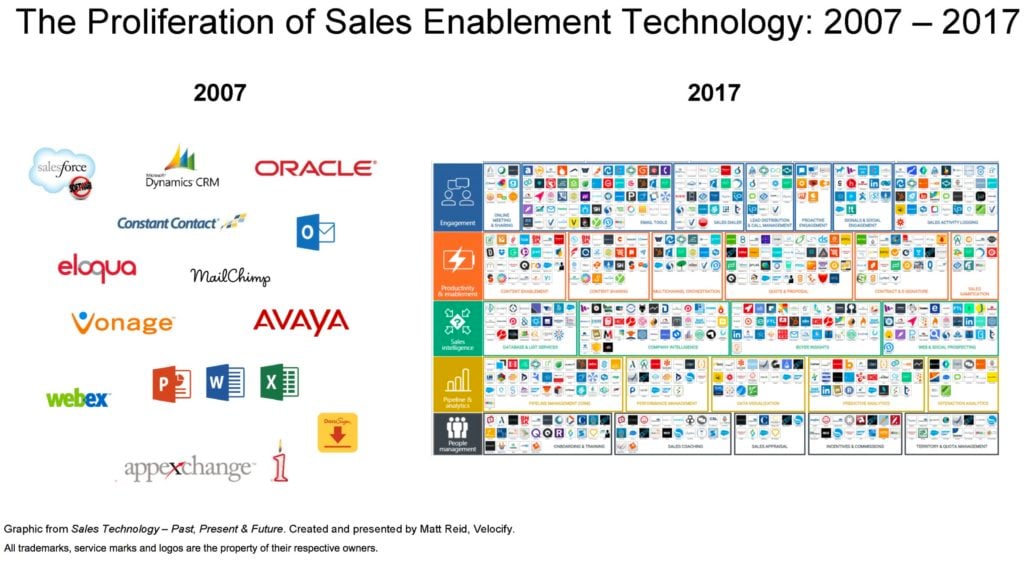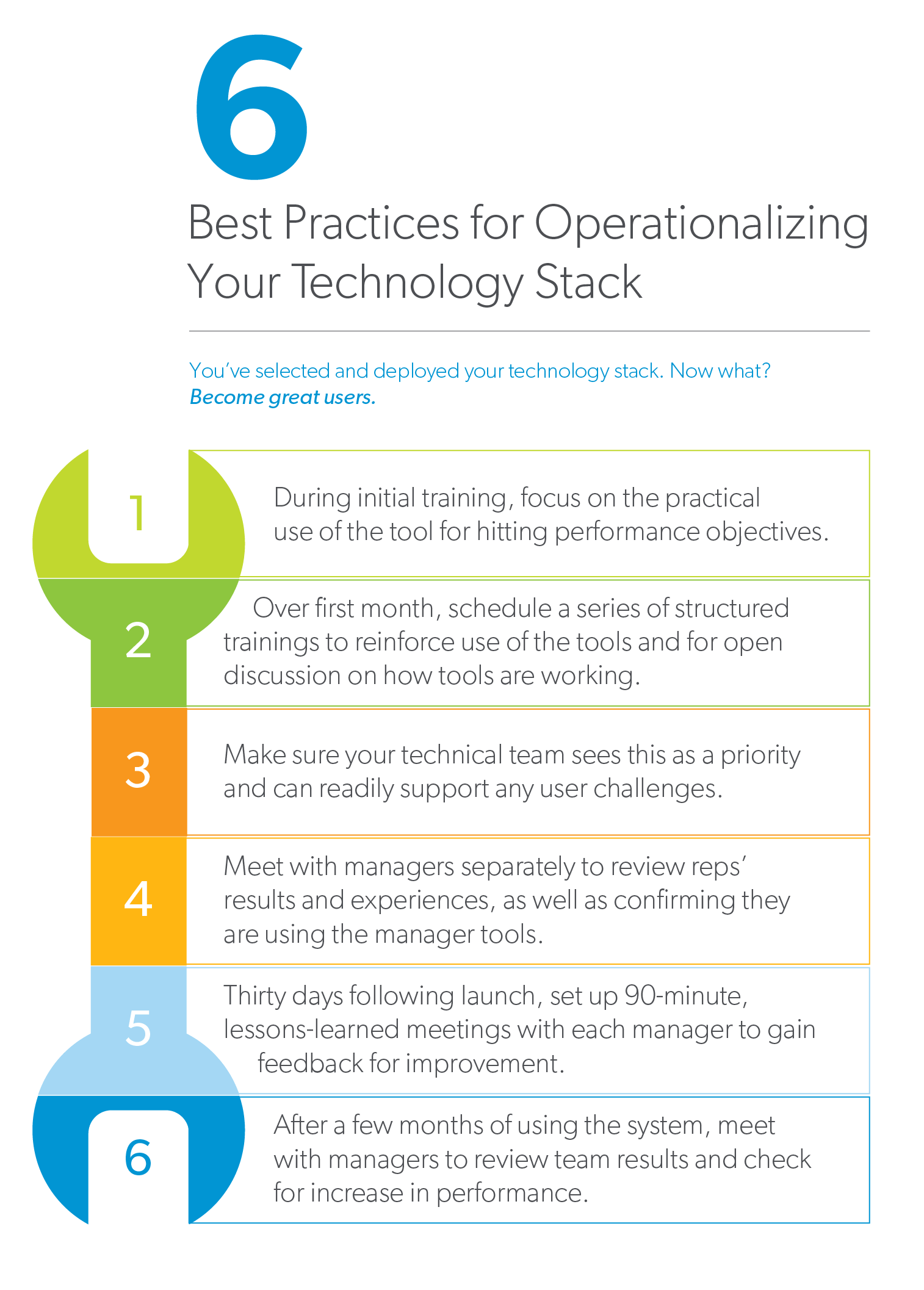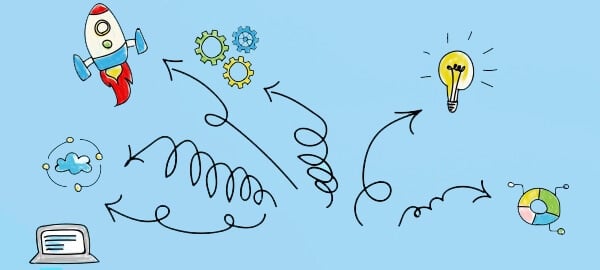The sales enablement landscape has exploded, with thousands of companies touting automation, predictive analytics, artificial intelligence, machine learning, and productivity enhancements. Finding the right sales enablement strategy for your company can be confusing, mainly because evaluating and ultimately purchasing the right technology for your business requires knowledge of the available solutions. And to effectively implement the strategy, it requires the right components to be in place within your organization.

When looking to deploy a sales enablement stack, it’s important to look beyond just sales and broadly consider the entire sales lifecycle from demand creation to servicing a customer for life. In most organizations, this includes several separate departments. For example, marketing is engaged in demand creation and lead development, while sales is typically focused on qualifying leads and closing deals. Then there’s fulfillment, which handles order entry and customer service following the sale.
So, what should you consider when evaluating enablement tools? To avoid costly mistakes, make decisions based on your buyer’s journey and by examining your people, processes, and existing technology.
Start with Your Buyer’s Journey
B2B buyers are becoming more and more like B2C buyers in that they are researching options online, scanning articles, listening to social media, etc. prior to making a purchase. And why wouldn’t they? There is so much information out there at their fingertips. They need only get online and join in the conversation. Embrace this change by implementing digital and omnichannel approaches.
In a study by Forrester, 68% of B2B buyers said that it is important to be able to view all their activities across all channels. It also found that two-thirds of B2B companies say their customers are expecting omnichannel capabilities from them, with 60% of respondents expecting to see a rise in customer satisfaction metrics from omnichannel initiatives. And, more than half the respondents anticipate that omnichannel customers have higher lifetime value. It’s easy to see that technologies supporting multiple touchpoints and an omnichannel approach are certainly needed.
Streamline Your Process
Review your marketing, sales, and customer service processes to ensure they are streamlined and have eliminated non- or low-value tasks. Think about “red time” and “green time.” For instance, are processes being performed merely because they always have? If so, you are only automating a bad process and accelerating bad results. It’s important that as many steps as possible lead to intended outcomes, and applying technology to an ineffective process will not lead to those expected results. You must optimize your process before you apply technology to it.
Once you have streamlined your process, sales playbooks are extremely effective for making sure people are following a consistent sales process and enabling you to get new sales reps onboarded more quickly to meet sales objectives. Business process engineers (BPEs) and instructional designers (IDs) create our sales playbooks. BPEs ensure that we apply the science of engineering to our sales by modeling a day in the life of our sales reps, which examines each process these reps use to achieve their goals and objectives.
Understand Your People
People learn differently. Some learn from hearing, some from watching, and some from doing. This is a major factor when considering technology. You also have to consider that millennials are dominating the American workforce, bringing with them a significant set of changes to how we work and lead teams. Understanding the gaps in how your teams learn is critical to implementing the most effective sales training curriculum. IDs are skilled at understanding different adult learning styles and know the ideal teaching method to build the most effective training curriculum for closing those gaps.
Start with an assessment to help you know where to begin. An assessment tool is great at helping you understand the skills, acumen, behavior, and intelligence of your teams. Such tools can identify hunters versus farmers, fixed versus open mindsets, work ethic types, and technology adopters versus resisters. This is especially important when deploying sales specialists by role.
Once you know their skills and weaknesses, coaching is critical to ensuring your teams are applying the new skills they have learned. As a leader, you want your people playing to their strengths—while you coach them through their weaknesses. Recently, we were told that 80% of sales managers say they conduct sales coaching, while 80% of reps say they do not receive sales coaching. So for many, training is informal or at best ad hoc. There’s not much formal coaching taking place.
Use software that ensures managers are performing individual coaching and focused on the most impactful areas. Document formal training and align with key performance metrics. Combining tools like UPtick with WideAngle helps you understand the gaps, provide suggestions for improvement, and facilitate one-on-one coaching sessions. It’s important for coaching to become a process and not an event.
Look for tools that integrate with your customer relationship management (CRM) system, so you can capture key metrics and provide the appropriate coaching when it comes to helping your team achieve specific objectives. ExecVision provides useful information, such as the amount of time a sales rep is talking versus listening. With this tool, you have the ability to listen to your sales reps’ conversations with prospects and customers, isolate areas for improvement, focus on key selling techniques, and develop best practices. Improving the quality of these conversations is critical to meeting sales objectives.
Assess Your Technology
Practice makes perfect. Salespeople need tools that will help them practice their pitch and positioning statements, learn ways to overcome objections, provide assessment and recommend solutions, build relationships, and master their craft. These techniques require complex preparation in some cases.
Tools such as CommercialTribe provide your teams with a safe and effective way to prepare and practice for sales meetings. One best practice in using these tools is to establish certification levels based on proficiency. Both tools enable managers to observe and certify their sales reps, which is often more difficult with field sales teams. Again, training tools are more effective when integrated with your CRM system.
Once you have the right process, skills, and abilities—as well as the best coaching and training tools in place—it’s finally time to look at driving productivity for ways to apply predictive capabilities. Sales enablement platforms, such as InsideSales.com, use analytics to determine the best time to contact a prospect or customer, as well as the probability of success. They also use techniques to determine the proper sales cadence for each prospect and sales motion.
Gamification is another best practice for motivating sales reps to drive productivity and profitability. Using the Power Standings feature of InsideSales.com and/or tools like Ambition are outstanding ways of increasing motivation—and are particularly effective for millennials.
However, it’s not about the technology. Don’t spend too much time analyzing the multitude of tools in this ever-growing landscape. There is likely to be a large consolidation in the sales enablement space in the next five years, leaving fewer providers and platforms. It’s more important to vet technologies and platforms quickly, identify a few use cases, and learn from the process of using them. The goal is to become great users of such technologies to achieve greater sales.
Be sure to establish baseline metrics to accurately determine the effectiveness and measure the value. Key metrics are time, count, quality, and cost.
- Are your teams more effective (calls, contacts, demos, leads, opportunities)?
- Is the time to close or other key processes getting shorter?
- Is the quality of the deals in your pipeline improving?
- Are leads more qualified?
- Is the cost of sales and customer acquisition decreasing?
- Are your reps hitting quota more consistently?
- Is customer erosion decreasing?
Get Started
To begin the process, make sure you record the current baseline metrics (whether your teams have already been using some types of technology or not), so you have a starting point to measure the effectiveness of the new technology.
Once your technology stack has been selected and deployed, the goal is to become great users. No matter how innovative and brilliant the technology, your teams may not easily adopt it or jump on board. A little handholding could be required with some of the technology, such as CRM and telephony systems. And, just making it a job requirement isn’t enough; users need to understand the benefits for them. So, you may need to go beyond the initial training and any job aids built and schedule multiple, brief training sessions, which will not only help adoption but also drive effective use of the tools.
When it comes to your managers, they must be on board with the new technology stack. Those who are tech-savvy will probably be excited about the new tools and take the time to learn how to use them well. (You want to clone these men and women, right?) However, you will also have those managers who need to be taught to be great users, so they’ll be equipped to train new reps or assist current team members who haven’t quite figured out how to use the tools most effectively.
Once the tools are rolled out, your operations and training organizations need to stay engaged to make sure reps and managers are not struggling. Below are some suggested best practices that may help you operationalize your technology stack.
- Initial training should focus on the practical use of the tool and how it can help them hit their performance objectives.
- Schedule a series of ongoing training over the first month to create a structured forum for reinforcement and open discussion on how the tools are working.
- Keep your technical team involved in any user challenges being experienced and help them understand the business impact to the reps.
- Meet with managers separately to go over the results of their reps and check to see if they have been using the manager tools, so you can uncover any potential challenges related to the technology.
- About 30 days after launching, set up 90-minute, lessons-learned meetings with each manager to gain feedback on how the tool can be improved or ways the training could be more effective. This will be important for improving the training for future users.
- Allow a few months for employees to use the system then meet with managers to review team results and check for an increase in performance.

When deploying and using any technology stack, the bottom line is to make sure your training is solid, your users and managers are allowed input, you’re tracking results after establishing baseline performance metrics, and you’re involving your technical team in the feedback from the reps and managers.
Let Us Help
At MarketSource, experience has shown us that successful sales initiatives aren’t about having more boots on the ground; they’re about having the right people in those boots. We help organizations deliver fantastic results by rigorously training and supporting highly specialized teams of sales professionals, brand ambassadors, product experts, and passionate professionals to engage with their customers. We then go a step further to bring that same immersive training to your internal teams and external partners.
By delivering a swift and seamless expression of your brand in support of critical business objectives, we can help you achieve better experiences, better relationships, and better sales. Contact us today for an assessment and let’s get started.

